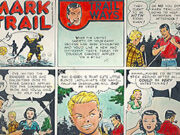Ed Dodd combined his affinity for the outdoors with his artistic talent to create the comic strip Mark Trail. Spending most of his career in Georgia, Dodd was a widely recognized proponent of the natural environment, an advocate of conservation, and a teacher of outdoor lore in mid-twentieth-century America.
Edward Benton Dodd was born in LaFayette, in Walker County, on November 7, 1902, to Jesse Mercer, a Baptist minister, and Effie Cooke. As a child, Dodd immersed himself in sketching, drawing, and painting.
Dodd’s interest in nature and art developed early in life. Beginning in 1920, Dodd worked each summer for more than a dozen years at a boys’ camp in Pennsylvania. His experiences at the camp, which was run by Dan Beard, a founder of the Boy Scouts of America, led to Dodd’s becoming a scoutmaster in Gainesville, where he taught physical education in the city schools during the 1920s. Following a brief enrollment at the Georgia Institute of Technology, where he illustrated the yearbook, Dodd studied in New York at the Art Student League. In 1926 he took a job in Wyoming at a dude ranch, then worked as a mule pack guide in Yellowstone National Park. All the while Dodd continued his efforts at breaking into professional cartooning.
In 1930 Dodd became a professional cartoonist, publishing a daily single-panel cartoon of humorous family life called Back Home Again in the Atlanta Journal. This and other briefly published series paid little money, and in the mid-1930s Dodd traveled to Norway, where he worked with sailors in the fishing industry. Meanwhile, he continued his Back Home series via mail.
Following more Art League study in New York, the plot for an outdoor cartoon series continued to evolve in Dodd’s imagination, but publishers initially rejected his ideas. Finally, the Post-Hall newspaper syndicate accepted the concept for a cartoon featuring an outdoorsman, whom Dodd had originally named “Jim Tree” but had renamed “Mark Trailer.” The syndicate changed the name to “Mark Trail,” as well as the names of the girlfriend, who became “Cherry,” and of the fictional setting, which became “Lost Forest.”
Mark Trail first appeared in April 1946. Dodd’s stories revolved around Trail (whom some see as the artist’s alter ego), an outdoorsman, writer, and photographer; Cherry, his girlfriend; and Andy, his St. Bernard. Their adventures were set at Lost Forest, Trail’s nature preserve and home. (Sandy Springs, a suburb of Atlanta, was the model for Lost Forest.) During its peak in the 1960s and 1970s, the strip appeared in hundreds of U.S. and foreign newspapers.
Dodd’s syndication success created the need for assistants. He hired Jack Davis (who later became famous for his Mad magazine art), Tom Hill, Rhett Carmichael, and Jack Elrod. Dodd turned chiefly to writing the narratives while his assistants did the artwork.
Mark Trail’s visibility and credibility as a wilderness educator and sportsman led to a number of offshoots from the comic strip. Sponsored by various conservation groups and corporate entities, several publications aimed at encouraging the responsibility of youth toward nature and the outdoors were written and illustrated around the Mark Trail character.
Dodd was named Honorary Chairman of National Wildlife Week in 1952-53 and Georgia Conservationist of the Year in 1967. He retired from his work on Mark Trail in 1978, giving the strip over to Elrod. The spirit of Dodd, through Trail’s adventures, thus continues into the twenty-first century.
Dodd died on May 27, 1991, in Gainesville, where he and his third wife, Rosemary, lived and promoted the cartoonist’s philosophy through his Mark Trail/Ed Dodd Foundation. An extensive permanent exhibit devoted to Ed Dodd and Mark Trail is on display at the Northeast Georgia History Center at Brenau University in Gainesville.




